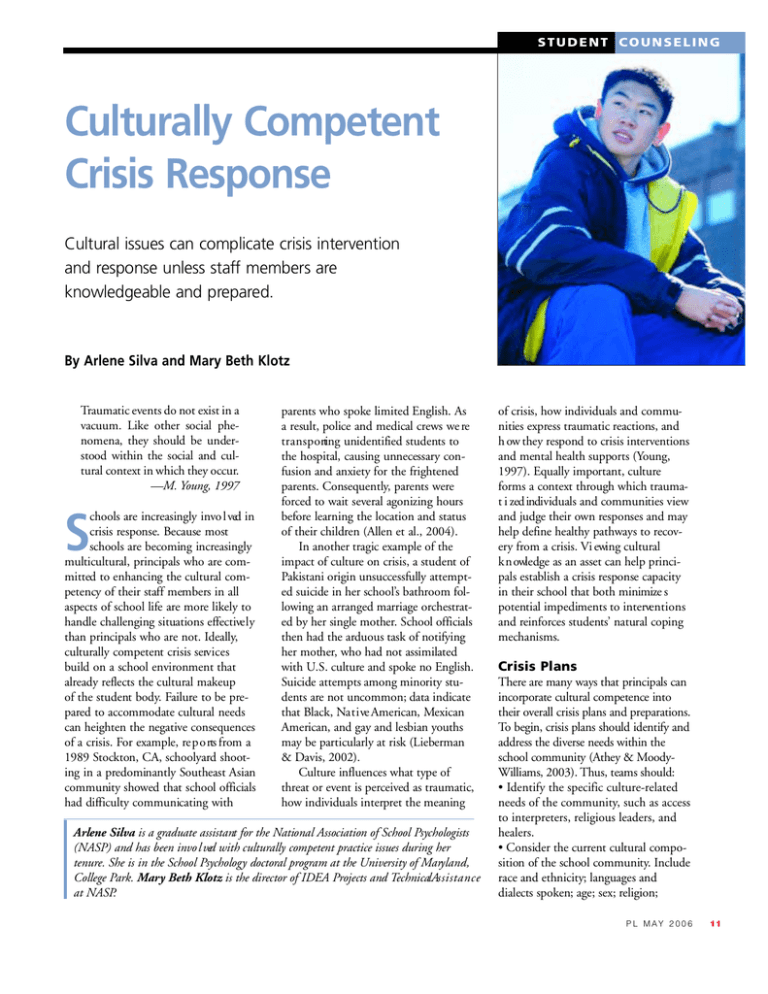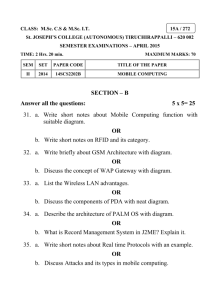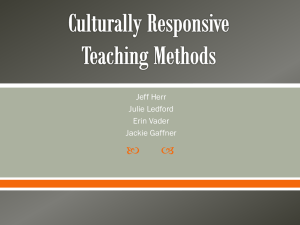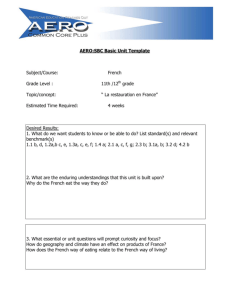Culturally Competent Crisis Response
advertisement

STUDENT COUNSELING Culturally Competent Crisis Response Cultural issues can complicate crisis intervention and response unless staff members are knowledgeable and prepared. By Arlene Silva and Mary Beth Klotz Traumatic events do not exist in a vacuum. Like other social phenomena, they should be understood within the social and cultural context in which they occur. —M. Young, 1997 S chools are increasingly invo l ved in crisis response. Because most schools are becoming increasingly multicultural, principals who are committed to enhancing the cultural competency of their staff members in all aspects of school life are more likely to handle challenging situations effective l y than principals who are not. Ideally, culturally competent crisis services build on a school environment that already reflects the cultural makeup of the student body. Failure to be prepared to accommodate cultural needs can heighten the negative consequences of a crisis. For example, re p o rts from a 1989 Stockton, CA, schoolyard shooting in a predominantly Southeast Asian community showed that school officials had difficulty communicating with parents who spoke limited English. As a result, police and medical crews we re t r a n s p o rting unidentified students to the hospital, causing unnecessary confusion and anxiety for the frightened parents. Consequently, parents were forced to wait several agonizing hours before learning the location and status of their children (Allen et al., 2004). In another tragic example of the impact of culture on crisis, a student of Pakistani origin unsuccessfully attempted suicide in her school’s bathroom following an arranged marriage orchestrated by her single mother. School officials then had the arduous task of notifying her mother, who had not assimilated with U.S. culture and spoke no English. Suicide attempts among minority students are not uncommon; data indicate that Black, Na t i ve American, Mexican American, and gay and lesbian youths may be particularly at risk (Lieberman & Davis, 2002). Culture influences what type of threat or event is perceived as traumatic, how individuals interpret the meaning Arlene Silva is a graduate assistant for the National Association of School Psychologists (NASP) and has been invo l ved with culturally competent practice issues during her tenure. She is in the School Psychology doctoral program at the University of Maryland, College Park. Mary Beth Klotz is the director of IDEA Projects and TechnicalAs s i s t a n c e at NASP. of crisis, how individuals and communities express traumatic reactions, and h ow they respond to crisis interventions and mental health supports (Young, 1997). Equally important, culture forms a context through which traumat i zed individuals and communities view and judge their own responses and may help define healthy pathways to recovery from a crisis. Vi ewing cultural k n owledge as an asset can help principals establish a crisis response capacity in their school that both minimize s potential impediments to interventions and reinforces students’ natural coping mechanisms. Crisis Plans There are many ways that principals can incorporate cultural competence into their overall crisis plans and preparations. To begin, crisis plans should identify and address the diverse needs within the school community (Athey & MoodyWilliams, 2003). Thus, teams should: • Identify the specific culture-related needs of the community, such as access to interpreters, religious leaders, and healers. • Consider the current cultural composition of the school community. Include race and ethnicity; languages and dialects spoken; age; sex; religion; P L M AY 2 0 0 6 11 STUDENT COUNSELING refugee and immigrant status; income and pove rty levels; percentage of students living in rural and in urban areas; h i s t o ry of trauma, torture, or war experience; and history of racial and ethnic relations within the greater community. • Identify formal and informal community resources that can help meet diverse mental health needs. • Develop a list of community members who can lend assistance as interpreters and translators in the event of a crisis. • Identify the meaning of suffering, pain, and death relevant to the norms of the community’s cultural groups (Young, 1997). • Anticipate and identify possible solutions to cultural problems that may arise in the event of a crisis. • Identify the full names of the parents and guardians of all students in the school, because last names can differ within families. The Crisis Team The school- or districtwide crisis team plays an integral role in multicultural crisis response, and team members should be selected and trained accordingly. Ideally, team members should represent the cultural and linguistic makeup of the school community (Allen et al., 2004). When this is not feasible, the team should train and develop strong working relationships with outside cultural brokers, interpreters, and relevant community members who are willing to be trained to assist in a crisis. Ongoing team training topics can include awareness of cultural values and traditions, linguistics and literacy, immigration experiences and status, help-seeking behaviors, cross-cultural outreach techniques and strategies, and avoidance of stereotypes and labels (Athey & Moody-Williams, 2003). Crisis team members should also examine their own Additional Web Resources ■ NASP Crisis Resourc e s www.nasponline.org/NEAT/crisismain.html ■ NASP Culturally Competent Practice (includes crisis re s o u rc e s ) www.nasponline.org/culturalcompetence/index.html ■ Center for Trauma, Response, Recovery, and Pre p a redness (Cultural Competency and Disaster Mental Health) www.ctrp.org/resources_cultural_comp.htm ■ Mental Health: A Report of the Surgeon General. Overview of Cultural Diversity and Mental Health Services www.surgeongeneral.gov/library/mentalhealth/chapter2/sec8.html The following Web sites contain information that can provide a starting point for learning about various cultural and religious traditions: ■ Death, funeral traditions, and mourning www.obituariestoday.com/Resources/FuneralEit.cfm www.beliefnet.com/story/78/story_7894_1.html www.funeral.com/funeral/index.jsp?dirID=33560 ■ Funeral flower etiquette by religion www.800florals.com/care/faiths.asp 12 P L M AY 2 0 0 6 cultures, worldviews, and biases, including how these may affect the provision of mental health services. Examples of issues to examine include verbal and nonverbal communication styles; a p p ropriateness of physical contact and p roximity when speaking with someone; the influences of extended families, tribes, and religious organizations; and beliefs about the ability to control events in one’s life. All of these issues can affect responses to crisis (e.g., Sa n d oval & Lewis, 2002). In addition, crisis teams should establish relationships with community resources, including trusted organizations, service providers, cultural and faith-based community leaders, multicultural television stations, radio stations, and newspapers (Athey & Moody-Williams, 2003). Gathering information from and establishing working relationships with these community resources can speed up and i m p rove effectiveness of response effort s following a crisis. To ensure continual cultural competence, crisis teams should conduct re g ular evaluation of their crisis response e f f o rts (Athey & Moody-Williams, 2003). This can include a needs assessment of the school and the community and investigation of any barriers that are present during a crisis. Reactions When a crisis occurs, principals and other responders should keep in mind that surv i vors react to and recover from crises within the context of their individual backgrounds, viewpoints, and values (e.g., Athey & Moody-Williams, 2003). Depending on the scope of a crisis, staff members may be responding to the needs of students from many different cultures both in the immediate aftermath of the event and throughout the recove ry process. Expression of emotion; description of psychological symptoms; help-seeking behaviors; natural s u p p o rt networks; and customs in dealing with trauma, loss, and healing often va ry by culture. It is also important to consider such historical influences as racism and discrimination, war and internment, and social and economic inequality when preparing a crisis response. These factors may cause minority groups to distrust offers of assistance, feel anger, blame others, and h a ve limited access to resources. In addition, groups who have previously experienced trauma (e.g., refugees) as well as those who have limited access to resources may be more susceptible to harm from crises. Cultural Bro k e r s Principals should work with school psychologists and other trained school mental health providers to ensure that the crisis response is tailored to the population in need. One way to do so is to include crisis responders and cultural brokers (e.g., community leaders) from the affected minority groups before, during, and in the aftermath of any crisis situation. In addition, communitybased groups can provide an important communication link with the cultural g roups they represent (Athey & MoodyWilliams, 2003). It is worthwhile to involve such community organizations as faith-based organizations, health and social service providers, and nonprofit advocacy organizations in crisis preparation and response planning as well as in training with school crisis teams. To ensure an organized response, crisis responders should coordinate their work with one another as well as with public and private agencies. occur. In addition, correspondence should always be supplemented with other forms of communication, such as radio and television announcements and printed bulletins or flyers that are distributed in the communities. Ideally, the primary language of crisis survivors should be used in delivering outreach services. When native speakers are unavailable, interpreters who have a basic knowledge of crisis response and who are also trained to accurately convey the tone, level, and meaning of the information presented in the original language should be re c ruited (Athey & Moody-Williams, 2003). This is important because one of the responsibilities of a crisis responder is to assess the severity of the individual’s reaction and determine whether they need additional mental health supp o rt. It is usually inappropriate to use survivors’ friends and re l a t i ves as interp reters, however, and all interpreters should be sensitive to confidentiality issues. On an interpersonal level, responders should remain aware of culturally specific communication techniques such as the use of eye and physical contact and physical proximity, the expectation of eating or drinking during discussions, the pace of conversation, and body language. P roviding Services Following a crisis, care should be taken to provide services that are accessible, appropriate, and equitable. He re are some tips for coordinating with school s e rvice providers to achieve these goals: • Be aware of cultural social status and sex conventions. Try to match re s p o nders to students and families so they will have a high level of acceptance within the culture in question (Sandoval & Lewis, 2002). • Ask survivors to describe what assistance they need from you. Then, tell them truthfully what assistance is within your capacity to provide (Young, 1997). Advertisement Communication When a crisis occurs, disseminating timely information to the affected community is of utmost importance. To reach all members of the community, information should be conve yed in languages other than English, including sign language as needed (Athey & Moody-Williams, 2003). Form letters in multiple languages can be prepared in advance for predictable tragic events (e.g., deaths in the school community) and adapted quickly when such events P L M AY 2 0 0 6 13 STUDENT COUNSELING Red Lake Nation As the smoke from the burning of sage and tobacco rose into the sky, prayers of healing were offered up by participants from the Red Lake Nation in Minnesota. The prayer circle was being conducted to provide spiritual comfort to a community that had just experienced the worst school shooting in the United States since Columbine nearly six years before. For an hour, elders prayed and shared stories. In the middle of the ceremony, an eagle circled overhead, symbolizing that the prayers were being carried to the spiritual Maker. This ceremony is a vivid example of the role of culture in crisis reaction and recovery. It was just one of many Native American traditions that shaped the response of the Red Lake community in the aftermath of the shootings. School personnel worked closely with tribal leaders throughout the process, building on the existing relationship among the school, the tribal leaders, the students, and the student's families. One particular challenge in this case, given the scale of the tragedy, was the need for support from experts in school-based crisis response. It was essential that the principal and the elders ensured that outside responders understood the unique cultural needs of community. They were very selective in who they invited to respond and talked with responders before their arrival. Frank Zenere, chair of the National Association of School Psychologists' National Emergency Assistance Team (NEAT), was one of the crisis responders invited to help provide these important support services. “Doing my homework ahead of time and being aware of the cultural, religious, and spiritual traditions of the Red Lake community were essential to providing relevant interventions,” Zenere reported when asked to reflect upon his experiences at Red Lake. As a result, the NEAT team included a school psychologist who is a Native American and who could act as a cultural broker during the response process. The NEAT Team also made a special effort to be sensitive to the cultural priorities of the community, such as understanding the close-knit nature of the people and their sense of a shared responsibility for the tragedy. The young man who was the shooter was viewed as the perpetrator and as a victim. The circle of elders, who play an important role in guiding the community, felt that the eroding of tribal traditions had lead to the shootings and saw the shooter as a lost soul. The NEAT Team members met with tribal leaders and school staff members and adapted their intervention approaches accordingly. Indeed, the recovery processes focused on incorporating mental health support with the healing traditions of the tribe. The long-term hope was to help the children re-establish a stronger identity with their Native American heritage. Although many of the circumstances at Red Lake are unique, the issues related to incorporating cultural strengths underlie any school crisis response. All principals can learn from Red Lake's efforts by considering culture in the creation and review of their crisis prevention, preparedness, and response plans, advises Zenere. Principals should factor culture into their crisis response plans by considering the comfort level of the community in terms of accepting mental health services, knowing the role of faith-based services for your community, identifying the key cultural issues to emphasize with outside responders, and having an extensive list of resources such as translators of key languages available. Frank Zenere, Ed.S., is the crisis management specialist for Miami Dade County (FL) Public Schools. Visit NASP’s Crisis Resources Web page for additional information and directions for how to contact NASP's National Emergency Assistance Team (NEAT) at www.nasponline.org/NEAT/crisismain.html Listen to a portion of the prayer service at Red Lake on the Minnesota Public Radio at news.minnesota.publicradio.org /features/2005/03/22_rehab_redlakehealing 14 P L M AY 2 0 0 6 • Acknowledge your limitations and differences. These may include the inability to speak or understand the language as well as confusion over cert a i n customs, rituals, or spiritual understanding. Try to convey your sincere desire to learn about these customs to be able to more effectively offer support (Young, 1997). • Refer parents to culturally appropriate postcrisis resources, such as An Activity Book for African American Families: Helping Children Cope With Crisis (National Institute of Child Health and Human Development and National Black Child Development Institute, Inc., 2003. Available online at www.nichd .nih.gov/publications/pubs/hccc /activitybook.htm). • Organize culturally appropriate commemorations and annive r s a ry activities. Create informational handouts to explain these rituals and customs to the greater community (Athey & MoodyWilliams, 2003). • Monitor access to services, including crisis counseling, and design specific strategies to reach the unengaged as well as those whose traditions discourage seeking help (Project Liberty, n.d.). C u l t u re and Death Crises involving death present the added challenge of understanding students’ cultural and religious attitudes toward death and supporting their grieving processes. Perceptions va ry widely and school personnel need to take the time to find out students’ faith traditions and perspectives. The most i m p o rtant thing a principal can do is respect the views and wishes of the students’ families and to involve family members in the support process. Depending on the nature of the crisis, schools may want to incorporate religious or spiritual ceremonies in recovery activities. This decision depends greatly on the circumstances and the cultures re p resented in the school. In all cases, students, family members, and often community representatives should be invo l ved in planning such activities. Crisis Response Evaluation Once the primary crisis response phase has ended, principals should collaborate with their crisis teams to assess and evaluate the effectiveness of the response, including its cultural competence, to identify and resolve problems in the response process. Involving representatives from diverse cultural groups in the evaluation process can further this objective. Focus and discussion groups and other program evaluation methods can be used to assess the following elements: leadership, understanding of cultural competence, organizational c u l t u re, training, the cultural competence plan, and plan management. In addition, crisis teams should maintain logs of all interventions used during the response to evaluate those that worked well and those that need improvement. This way, future responders can shape their interventions based on past success with the community. Surveying key stakeholders can also be helpful to e valuate outcomes of the crisis response and to get useful feedback. Conclusion The Chinese word for crisis comprises two symbols: wei, which means danger, and ji, which means opportunity. Crises present both; how individuals and communities respond to a crisis dictates in g reat measure the degree to which risk is transformed into opportunity. Keeping students and staff members safe is the first priority in a crisis situation, but helping them become stronger through the process should be a goal for educators as well. Culturally competent crisis response is essential to helping students at the individual level and reinforcing a sense of community within a culturally diverse school. By capitalizing on school and community resources, supporting crisis team training, planning ahead, and evaluating crisis responses, principals can play a key role in establishing crisis response services that reflect and respond to the cultural needs—and strengths—of all students and their families. PL Note: This article is the third in a three-part Counseling 101 series that addresses culturally competent schools. It is adapted from Culturally Competent Crisis Response: Information for School Psychologists and Crisis Teams, which can be found on the NASP Web site at www. n a s p o n l i n e . o r g /culturalcompetence/cc_crisis.html. References ❏ At h e y, J., & Moody-Williams, J. (2003). De veloping cultural competence in disaster mental health programs: Guiding principles and recommendations. Washington, DC: U.S. De p a rtment of Health and Human Se rv i c e s . ❏ Allen, M., Annandale, N., Gstettenbauer, A., Ru t h e rf o rd, M., Lyman, B., & Conklin, E. (2004). Providing effective crisis intervention for students and families from diverse backgrounds. Paper presented at the National Association of School Psychologists Annual Convention, Dallas, TX. ❏ Lieberman, R., & Davis, J. M. (2002). Suicide intervention. In S. E. Brock, P. J. Lazarus, and S. R. Jimerson, (Eds.), Best Practices in school crisis prevention and intervention ( p p. 531–551). Bethesda, MD: National Association of School Psychologists. ❏ Project Liberty. (n.d.). Providing culturally competent crisis counseling serv i c e s . Retrieved from www.projectliberty.state .ny.us/Resourc e s / P LCultural.pdf. ❏ Sandoval, J., & Lewis, S. (2002). Cultural considerations in crisis i n t e rvention. In S. E. Brock, P. J. Lazarus, and S. R. Jimerson, (Eds.), Best practices in school crisis prevention and intervention (pp. 293–308). Bethesda, MD: National Association of School Psychologists. ❏ Young, M. (1997). The community crisis response team training manual (2nd ed.). Washington, DC: National Organization for Victim Assistance, Washington, DC. NASP Handout adaptation (Cultural perspectives on trauma and critical response) by Kris Sieckert. Available online at www.nasponline.org /NEAT/neat_cultural.html P L M AY 2 0 0 6 15








